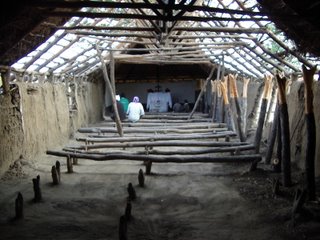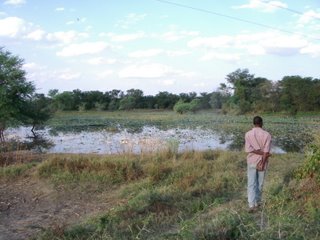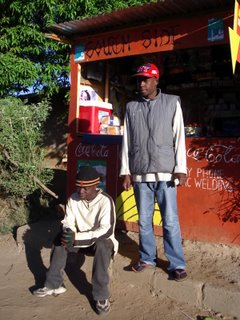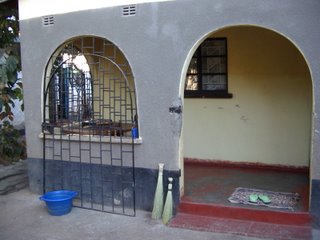First and Highly overdue impressions of Zambia
If you don’t want to read a whole lot, the quick synopsis is that everything is really chill here, the people are great, friendly and accommodating, and the weather is perfect- everyday.
I’ve been here for about 3 weeks, and no longer have any excuses for not writing. Initially the powercord for my laptop was “borrowed” at training, then the backpack that it was in got left in a taxi in Toronto and was never returned. But I have a new cord now, and the CARE office has satellite internet, so I figured I better make use of it and record some thoughts. I’ve been really busy since getting here, the 3 weeks has passed really fast and it’s been to easy to brush off writing.
The plan of this post I to let everyone know I’m still alive and kicking as well as give some of my first impressions of this cool and interesting country.
Update of what I’m up to
I’ve spent the first weeks getting accustomed to Zambia, then to my placement at CARE. Once I got accustomed to all that and I was confident that the summer would fly by I decided to start getting sick and injured, so I’m hopefully just getting over that now. The first sickness was a 30hr period of crazy amounts of vomiting, not yet sure of the cause, but I blame the small whole fish (Kapenta) we had for dinner, I think the hundreds of fisheyes on the plate somehow grossed me out, one of my Zambian friends was convinced that I had Malaria and that he cured me with two bottles of tonic water. Just when I was getting better from the vomiting, my coworker and I were doubling on his dirt bike through some sandy back roads when we fell and twisted my foot, which meant I had to take a day off as I limped to recovery. Then just as everything was looking up I appear to be coming down with a cold, but other than that things are going great.
As I mentioned in the last post I was unexpectedly shifted to Livingstone, which turned out to be a pretty sweet switch. Victoria Falls is magnificent and I dare say more so than Niagara Falls which is hard for me to admit. Livingstone is a bit of a tourist town; for me this means that there is ice cream and donuts available which is pretty much all I look for in a town. I’m staying with a family who is friends with the family that the EWB long term volunteer is staying with. They gave me my own room with a bathroom, although I feel pretty guilty because the rest of the family of 9 is sharing one bedroom and a shed as well as one bathroom that another family also uses. We have electricity and cold running water (my bath water is heating up on the two burner stove (which was purchased the day after I gave my rent money- feels good to help out..) heating up right now). We also have a fuzzy black and white T.V. that gets one channel which plays mostly soap operas and bad commercials that everyone in the family sings along to. The family consists of Mamma, 2 of her 5 children then 6 of Mamma’s grandchildren from her 3 other children who don’t live there. There is also a family of 4 living in the back of the house, they were supposed to move out before I got here, but for various reasons I think they’ll be pretty permanent. So overall it’s a great mix of people although slightly noisy at times, there seems to be pretty much constant screaming especially whenever you have a headache. One funny thing that came out of my being here is that I unknowingly let slip that my Zambian sister (housemate) Linda is 8 months pregnant, and the Father Ike is Mike’s (Long term volunteer) Zambian brother. Before I arrived, Mike’s house had no idea about the pregnancy, so I’ve accidentally caused a bit of drama, but on the bright side, now that the parents know Mike and I are going to see a Zambian wedding pretty soon.
My placement so far seems really great, I’ve spent my first 2 weeks at work just following around the Long Term volunteer Mike Quinn. We’ve been going to the field nearly everyday doing a whole plethora of things from training people how to use a brick making machine that CARE bought them 4 years ago, to judging fields in the Sorghum growing competition, to getting deliveries of Sorghum. I’ve actually been doing a surprisingly large amount of labour; helping load 50kg bags of Sorghum onto the delivery truck, and collecting stones and gravel for the Sorghum processing building. At one point due to some confusion in timing Mike and I and about 4 women from the neighbouring village had to load about 6 tonnes of rocks onto a truck by hand, one or two rocks at a time. It was really amazing to see how hard working some of these women are, one even had a baby on her back as she was helping, then when it started crying she swung it to the front and continued loading stones as the baby breast fed. My specific role in the placement is going to be a research project using positive deviance methods. Positive deviance is pretty cool, it assumes that the answers already exist, the positive deviants (really successful farmers) just need to be identified and displayed to everyone else. I’m going to be partnered with a Zambian agronomist who just graduated and should be joining me next week. We are going to look at a handful of the best and worst Sorghum farmers and try to identify what specific things were done to make some successful and some not. Then develop a training program to make sure that everyone is successful next year. It’s actually a bit trickier than it seems since there are a ridiculous number of factors that play into whether of not someone gets a good yield.
If anyone is interested in mailing me anything, or maybe sending some gifts for my Zambian Family you can reach me at
CARE International Zambia
P.O.Box 60256
Elaine Burtel
Livingstone, Zambia
Also I’ll be checking my e-mail regularly to fire some messages over. borzy1@gmail.com
First Impressions
No infrastructure- The lack of infrastructure became very apparent as I was scared of running out of runway as the plane landed in Lusaka. Zambia’s biggest airport had one runway and the terminal was no bigger than a big Canadian grocery store. Most big cities have power and water and that’s about it. Land line phones are very rare, calls to Canada are about $4 per minute. There is pretty limited transportation, Lusaka has “minibuses” which are extended vans that fit about 16 people and blow a lot of smoke, Livingstone just has taxi’s, and walking. I’ve yet to see an oven, the better off people have 2 electric burners and everyone else uses charcoal.
No spice- Food here is really ordinary. On our first day here we went on a scavenger hunt, one of the items that I was supposed to get was spice, so I tried to clarify but there was no point. The only spices you’ll find in Zambia are salt, and if you look hard you can find curry powder, as well as a red powder which seemed to have no flavour. For breakfast people eat plain white bread or buns and drink tea. For lunch and dinner people have nshima (corn meal porridge) and one of about 4 side dishes. In my house it is almost always the same side dish which is rape leaves, tomatoes, a bit of onion, and a lot of salt. It gets pretty boring, but I am starting to like it!
Weather- You never have to make plans around the weather here, weather forecasts would be useless because everyday is the same, sunny, warm and dry. The nights actually get pretty cold, there was frost one night, and I’ve been wearing my toque more than expected. The stars are brilliant every day, which is a pretty sweet bonus. Of my three weeks here, there have been 3 days with any sort of clouds; I am told that there is no chance of it raining all winter.
No takeout- It is difficult to find food, not as bad in Livingstone because there are lots of hungry tourists around, but generally if you want food and it is late at night or early in the morning, the only option is cooking it yourself, and with Nshima that can be quite a process.
Walls- People are super friendly, but for some reason they feel the need to put up big concrete block walls around the houses, often with barbed wire or broken glass on the top, all of the windows have bars as well.
Compounds- All the people live in compounds, which can sometimes be confused with slums. I live in Dambwa North Compound, which is just a big grouping of houses in the north of Livingstone. All the roads to my house are really sandy and difficult to walk unless you follow the path that the cars forge, but then you need to watch out for cars.
Direction of the drain- When I first arrived here I was excited to confirm that draining water spins the opposite way in the southern hemisphere, but I forget which way they go in the northern hemisphere, someone please let me know so I can confirm it!
Used clothes- It is very rare to find a store that sells new clothes in Zambia. The entire clothing market is based on reselling clothes that are donated in the developed world, so everyone here dresses exactly like we would have 15 years ago. Toronto blue jays shirts are quite popular as well as random hockey shirts. There used to be a big textile industry in Livingstone, but it was all shut down when the cheap used clothes flooded the market. This is good because people have nice clothes for cheap and it is an efficient use of resources, but lots of people lots their jobs, Overall Zambia imports way to much stuff.
Beer- Most of the beer is reasonably cheap and quite good, about $1 at a restaurant for a regular beer. There is also the Sorghum beer which is a bit cheaper and still tastes quite nice. On the bottom of the beer scale is the Chibuku or Shake Shake, this is corn mixed with Lactic acid and allowed to ferment, it is about $0.50 for a liter and has a higher alcohol content. The taste is almost like a bad wine mixed with vomit, the reason it is called shake shake is because you need to shake it to disperse the little corn particles throughout the drink. The local brews are a similar mix, but lower quality and much lower price. Lots of people drink too much, and lots of people don’t drink at all, there seems to be a lack of people who drink responsibly, but I suppose that is something to worry about once more people are drinking. I wonder what the correlation is between alcohol consumption and economic development.
No Selection- Unless you want to go to the Shoprite which is like a mini Wal-Mart filled with imported merchandise you selection is very limited. In the markets you can get a few different types of leaves, tomatoes, potatoes, onions, salt, some meats, sugar, corn meal, bread, concentrated juice, chocolate, some random hardware and really not a whole lot else.
Clean streets- All the garbage just goes in piles beside houses and it is burnt. Once in a while you get a nasty whiff of burning garage, but everything is generally really clean. Also sweeping is part of the Women’s livelihood, the sound of the thatch brooms wakes my up in the morning and it’s the last thing I hear before I sleep, they probably sweep the house and the patio about 7 times per day.
Chill- Everyone is really chill, often walking really slow, if you wanted to go somewhere without talking to anyone it is definitely possible, unlike in India. But if you want to talk to someone you can approach anyone and they will most likely be interested in spending some time chatting.
Lack or Stuff going on- There is really not a whole lot going on in Zambia, I’m not sure where they employ so many people. The big one is all the copper mines in the North, everyone else seems to be a teacher, work selling in the market, driving a taxi, farming, or the tourist industry. They could definitely use some investment in some industry to reduce their reliance on imports and create some jobs.
Cars- I was really shocked to see that there are almost no motorcycles in Zambia, 90% of the vehicles are Toyota cars, which doesn’t make sense to me. In Lusaka there was a sign saying that the Japanese government was responsible for lots of the roads here. I wonder if that came with a contract to only buy Japanese cars?
Shaving to the back of a cd- I took me a couple days to realize that there are no mirrors in my house, I think most of the women have small make up mirrors, and I have the back of a cd, which seems to work okay.
Animals- In generally there are only wild animals left in the National parks all the others have been poached out. Fortunately as we drive to the field almost everyday we go through a national park. So I’ve seen a bunch of Giraffes, Buffalo, Baboons, we’ve had to wait for Elephants to cross the road a few times, as well as some impala.
So that is what Zambia seems like to me, most of the posts in the future will be more specific about a particular person or thing.
Also Please let me know if there is anything that you are wondering about, I’m sure I’m missing lots of details so post a response and let me know what you want pictures of and what you want information about. Please let me know what your biggest assumption about Zambia is, and I can try to prove or disprove it.













